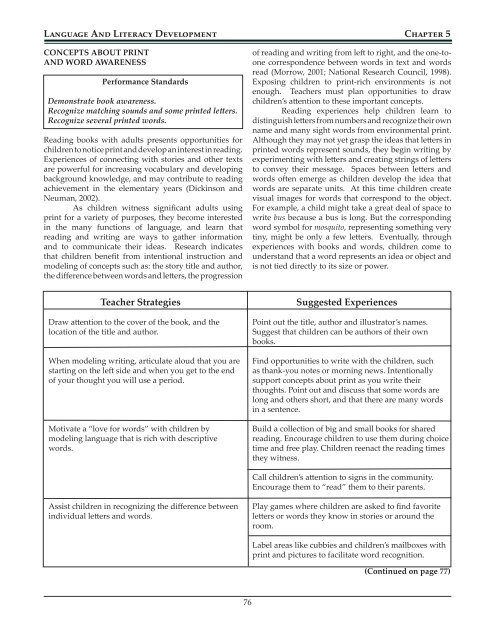Early Childhood - Connecticut State Department of Education
Early Childhood - Connecticut State Department of Education
Early Childhood - Connecticut State Department of Education
Create successful ePaper yourself
Turn your PDF publications into a flip-book with our unique Google optimized e-Paper software.
Language And Literacy Development Chapter 5<br />
CONCEPTS ABOUT PRINT<br />
AND WORD AWARENESS<br />
Performance Standards<br />
Demonstrate book awareness.<br />
Recognize matching sounds and some printed letters.<br />
Recognize several printed words.<br />
Reading books with adults presents opportunities for<br />
children to notice print and develop an interest in reading.<br />
Experiences <strong>of</strong> connecting with stories and other texts<br />
are powerful for increasing vocabulary and developing<br />
background knowledge, and may contribute to reading<br />
achievement in the elementary years (Dickinson and<br />
Neuman, 2002).<br />
As children witness significant adults using<br />
print for a variety <strong>of</strong> purposes, they become interested<br />
in the many functions <strong>of</strong> language, and learn that<br />
reading and writing are ways to gather information<br />
and to communicate their ideas. Research indicates<br />
that children benefit from intentional instruction and<br />
modeling <strong>of</strong> concepts such as: the story title and author,<br />
the difference between words and letters, the progression<br />
Teacher Strategies<br />
Draw attention to the cover <strong>of</strong> the book, and the<br />
location <strong>of</strong> the title and author.<br />
When modeling writing, articulate aloud that you are<br />
starting on the left side and when you get to the end<br />
<strong>of</strong> your thought you will use a period.<br />
Motivate a “love for words” with children by<br />
modeling language that is rich with descriptive<br />
words.<br />
Assist children in recognizing the difference between<br />
individual letters and words.<br />
76<br />
<strong>of</strong> reading and writing from left to right, and the one-toone<br />
correspondence between words in text and words<br />
read (Morrow, 2001; National Research Council, 1998).<br />
Exposing children to print-rich environments is not<br />
enough. Teachers must plan opportunities to draw<br />
children’s attention to these important concepts.<br />
Reading experiences help children learn to<br />
distinguishlettersfromnumbersandrecognizetheirown<br />
name and many sight words from environmental print.<br />
Although they may not yet grasp the ideas that letters in<br />
printed words represent sounds, they begin writing by<br />
experimenting with letters and creating strings <strong>of</strong> letters<br />
to convey their message. Spaces between letters and<br />
words <strong>of</strong>ten emerge as children develop the idea that<br />
words are separate units. At this time children create<br />
visual images for words that correspond to the object.<br />
For example, a child might take a great deal <strong>of</strong> space to<br />
write bus because a bus is long. But the corresponding<br />
word symbol for mosquito, representing something very<br />
tiny, might be only a few letters. Eventually, through<br />
experiences with books and words, children come to<br />
understand that a word represents an idea or object and<br />
is not tied directly to its size or power.<br />
Suggested Experiences<br />
Point out the title, author and illustrator’s names.<br />
Suggest that children can be authors <strong>of</strong> their own<br />
books.<br />
Find opportunities to write with the children, such<br />
as thank-you notes or morning news. Intentionally<br />
support concepts about print as you write their<br />
thoughts. Point out and discuss that some words are<br />
long and others short, and that there are many words<br />
in a sentence.<br />
Build a collection <strong>of</strong> big and small books for shared<br />
reading. Encourage children to use them during choice<br />
time and free play. Children reenact the reading times<br />
they witness.<br />
Call children’s attention to signs in the community.<br />
Encourage them to “read” them to their parents.<br />
Play games where children are asked to find favorite<br />
letters or words they know in stories or around the<br />
room.<br />
Label areas like cubbies and children’s mailboxes with<br />
print and pictures to facilitate word recognition.<br />
(Continued on page 77)

















